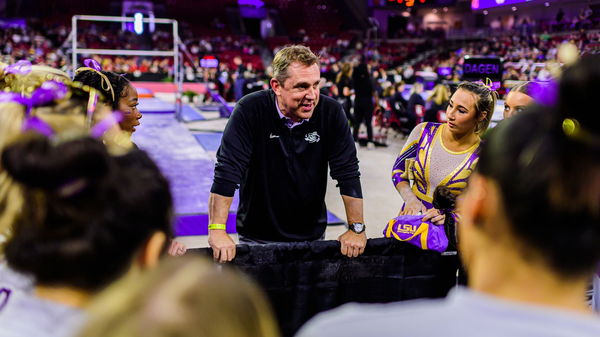

With LSU Gymnastics set to kick off their NCAA season on January 3 against Iowa State, the fans are pumped up. But this year, there is an additional flavor! After a long and heated debate, the NCAA and Power Five Conferences agreed in May 2024 to let schools pay the student-athletes for the first time in history. This means that universities can afford to allocate some amount of money to be divided among athletes who belong to the athletic departments; this leaves schools to decide how to apportion resources equally between men and women.
Watch What’s Trending Now!
However, though Title IX mandates equal division between men’s and women’s athletics, so probably money will be divided equally by the institution. And now, a recent guest in this series is Coach Jay Clark from LSU Gymnastics, who expressed a rather different opinion about the NCAA’s rule change that started some discussions.
In an episode of the All Things Gymnastics podcast published on December 30, LSU head coach Jay Clark shared a thought-provoking perspective on the evolving landscape of college athletics. When introduced, the host noted, “LSU head coach Jay Clark, who sees things a little bit differently. He talks about how he feels that there’s enough talent in the country for everybody to reap the benefits of a larger roster.” Jay Clark answered, adding that there is one more perspective to the problem, saying, “The argument can be and has been made that it will allow the rich to get richer, and that it will pull from other schools. I don’t see it that way.”
ADVERTISEMENT
Article continues below this ad

ADVERTISEMENT
Article continues below this ad
According to Clark, talent will always seek to go to those areas that the individuals feel comfortable in, not because of the amount of money to be earned. He used one example of Chase Brock, the gymnast who joined the team as a walk-on and chose to go to LSU over other colleges because it was the right thing to do. “Chase Brock has been here as a walk-on just where she wanted to be. She could have gone any number of other places. This is where she wanted to be. So she still wasn’t going somewhere else, even if she was on her own dime.” According to Clark, this sentiment reflects the broader truth: “There’s enough talent out there, I believe, for it to be sustainable for us all.”
Chase Brock, who is now a senior at LSU gymnastics, has been a favorite since she first joined the Tigers in 2021. In vaults and bars, she appeared to be especially powerful and quickly became a solid value. During her performances, the world saw Brock in her best score; 9.975 on vault and 9.875 on bars, to mention but a few. However, with the recent changes in the NCAA, not only the scores have changed—the playbook and game rules that have influenced how teams play and how they intend to strategise has also changed!
What’s your perspective on:
Is LSU's Jay Clark right in believing talent will find its home, regardless of financial incentives?
Have an interesting take?
NCAA gymnastics sees changes in their playbook!
USA Gymnastics and NCAA have some new rules and clarifications coming into this season, and I’m not going to lie, the gymnastics community is feeling all the emotions! First up, athletes can now wear shorts, tights or leggings over or under leotards, which brings some much needed comfort and flexibility to the sport. But let’s not get too comfy because the “finishing position” rule is crystal clear now. Gymnasts must stand on their legs, straight, arms up, and frozen for one second–no smiles, no waving, no fist pump or dancing during the routine. It’s all about the poise, people! Oh, and just in case you hadn’t noticed, getting points became slightly more difficult as well. When a score is above 9.8, the judges must be within the one-tenth proximity to each other, and that’s as fair and fabulous as it gets for those spectacular performances.

ADVERTISEMENT
Article continues below this ad
However, the updates are no longer only of the rules and regulations; they have also included some attitude. On vault, the direction lines on the landing mats are receiving more focus. However, we are still unsure about those three-tenth reductions. That being said, bars received a genuine glow up! Gymnasts now require a ‘C dismount followed by a C vault’ and new release skills to continue that bonus. The NCAA is demanding more variety, and we may not see as many Maloney to Pak sequences and more of those cool Shaposhnikova and Chow. And of course we cannot forget beam drama! Do you recall when Leanne Wong removed the beam cap during her dismount in the previous year? Well, that is no longer considered “equipment failure.” Now, any wobble, fall, or incomplete dismount has to be blamed on the gymnast. Here is clarity, people, and it is long overdue.
Last but not the least; floor is now getting even more difficult with a new rule that mandates two acro passes on two different diagonals—making gymnasts own the entire floor. Judges don’t like to track patterns, but come on, artistry plus athleticism, right? The double-back-as-a-last-pass bonus also received a slight change; gymnasts must perform additional saltos to get that bonus point. This change should add some excitement to routines with higher tumbling difficulty and stamina. In totality, all these updates are expected to add more accuracy, imagination and ‘wow factor’ to the mat. Well, here’s the good news for the gym lovers: get ready to be dazzled this season!
ADVERTISEMENT
ADVERTISEMENT
ADVERTISEMENT
ADVERTISEMENT



Is LSU's Jay Clark right in believing talent will find its home, regardless of financial incentives?